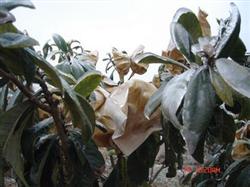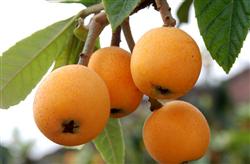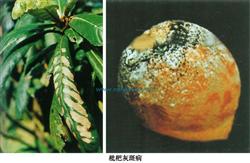Cultivation Techniques of Loquat for Freezing Resistance

1. The effect and harm of freezing injury on loquat flowering is "head flower" from October to November, the chance of freezing is the most, but the growth time is long, the fruit is big, and the quality is good; from November to December, the flowering is "second flower", the chance of freezing is less, and the growth period is shorter, but the quality is not much different from that of "head flower"; from January to February, the flowering is "three flowers", and the chance of being frozen is the least, but the growth period is the shortest, the fruit is small, and the quality is poor. Loquat flowers are easy to cause internal rot after freezing, the flower axis becomes brown and soft rot, and there is a viscous liquid flow out of the diseased part by hand, and in the later stage, the flower axis shrinks and dries up and wilts, resulting in flower rot; low temperature freezing injury inhibits the germination of loquat pollen grains, resulting in withered flowers and unable to set fruit; after the young fruit is frozen, the furry hairs on the fruit surface wilt, some parts fall off, making the fruit surface green and bright; when the freezing injury is serious, the young fruit becomes gray-black or dark brown and the young fruit falls off. The young fruit is larger and lighter frozen, and the pulp around the calyx tube is corked, forming fruit cork disease. Loquat leaves are not easy to be frozen, but they will wilt, wither and fall off after freezing. 2. Cultivation techniques for freezing resistance of loquat (1) choose flat or gentle sloping land with high dryness, ventilation and deep soil layer, and avoid frost in low-lying land. (2) choose the varieties with strong cold resistance and good fruiting characters, such as' Dawuxing', 'April Red' and so on. (3) using grafted seedlings, Photinia and other varieties with developed root system and strong cold resistance, which can improve the freezing resistance of loquat, were selected as rootstocks. (4) adopt protected cultivation. Bamboo, miscellaneous wood or steel pipe can be used to build a frame and covered with thin film. The covering time should be after the loquat blossoms or before the freezing injury. The loquat cultivated in greenhouse should uncover the film at the full flowering stage and cover again after the full flowering stage. After covering the film, we should pay attention to the changes of temperature and humidity in the shed, and properly open the doors and windows to adjust. (5) Flower and fruit management. In orchards that are likely to be frozen, you can appropriately postpone the time of thinning flowers and fruits, leaving no or less early flowers and fruits, and more "second flowers" fruits to avoid the frost period; or not thinning flowers and ears, and then combining fruit thinning to remove too many ears when the weather is warmer. Carry on the bagging treatment, or wrap the lower leaves of the flower spike upward, or wrap the young fruit exposed outside the crown with straw, and then cover it with rice straw. After the young fruit is frozen, fruit thinning and bagging should be postponed, and after the threat of frost is lifted, the young fruit whose seeds have blackened should be removed, and the unfrozen fruit should be bagged. For frozen fruit, the fruit protectant can be sprayed once within 10-20 days after freezing, and once again after 1 month, higher yield per plant and larger seedless fruit can be obtained. (6) pruning damaged branches and leaves. After the temperature rises steadily, we should take the measures of picking leaves with minor injuries, pruning with slanderous injuries and sawing dry with serious injuries. (7) cover the tree plate. Cover the tree plate with straw or plastic film before frost, or cultivate soil on the tree plate to prevent frost. (8) White tree trunks. Use 1.5kg quicklime + 0.2kg salt + 0.3kg sulfur powder + a little oil (to avoid Rain Water) + 5kg of water, mix into a paste whitening agent to whiten the trunk. (9) dry the roots. Pluck the soil before flowering, dry the backbone roots for 7-10 days, and then apply fertilizer to cover the soil, which can delay flowering and reduce the freezing injury of flowers and young fruits. (10) increase the application of organic fertilizer. The application of organic fertilizer can increase soil humus and improve aggregate structure, so as to increase soil temperature and prevent fruit tree roots from freezing. The management of fertilizer and water should be strengthened for frozen trees, and the fertilizers are mainly organic manure such as human feces and urine, chicken manure, cake fertilizer and rotten barnyard manure, combined with quick-acting fertilizers such as urea, compound fertilizer and calcium superphosphate; the root system of frozen trees has weak fertilizer absorption capacity and thin fertilizer should be applied frequently. After the new branches and leaves were ripe, 0.2% urea + 0.2% potassium dihydrogen phosphate and other extra-root topdressing for 1 and 2 times were used to restore the tree potential. (11) Orchard smoking. Before frost or cold wave comes, use rice bran, wet wood and weeds to light fire and smoke in the garden. Smoking materials or aerosols should be put in the upper hand of the orchard, 6-10 piles per mu, and the size and quantity of the piles should depend on the smoking materials. In order to prevent frost timely and effectively without wasting fuel, the time of smoke stack layout and ignition should be based on weather forecast and on-site observation. (12) after the trees of post-disaster pest control are frozen, the trees are weak, the ability of disease resistance is reduced, and it is very easy to cause damage to diseases and insect pests, so strengthening the prevention and control of diseases and insect pests is the focus of orchard work after the disaster, and fungicides and pesticides should be sprayed in time. Fungicides such as 50-fold Fumei arsenic or 5-fold fubiqing should be applied to the frozen trunk and the base of the main branch twice before sprouting to prevent rot.
- Prev

Technology of balanced fertilization for Loquat
According to the characteristics of fertilizer requirement, the growth of branches, roots and fruit development of loquat, the suitable fertilization period, fertilizer type, quantity and fertilization methods (pouring, hole application, furrow application or soil mulching after application, etc.) were determined. pay attention to the reasonable combination of nitrogen, phosphorus, potassium and organic fertilizer with inorganic fertilizer. (1) fertilization for young trees.
- Next

Integrated control of loquat gray leaf spot
Loquat gray leaf spot is also known as "wheel spot". It is the most important disease of loquat. Encroach on branches, leaves, flowers, fruits. There are two types of acute and chronic types: chronic disease spots on the leaves, initially light brown round spots, and then connected into irregular large spots, scattered small black spots. The disease of twigs is first caused by watery browns.
Related
- Moge, come on! The staff of the peasant association in the producing area of cantaloupe were frightened when the crowd gathered.
- Causes and Solutions of low Fruit setting rate of Apple
- Symptoms and control measures of passion fruit virus disease
- Fruit growing lesson: how do apple orchards keep high yields?
- Can you build orchards in the mountains? What are the pros and cons?
- How to manage the coloring period of Crisson grape?
- This paper introduces the processing technology of two kinds of fig products.
- How much is a month for retired teachers in rural areas by 2020?
- How can strawberry planting increase sugar content? We should pay attention to management in many aspects.
- What are the cultivation techniques on how to improve the yield of golden fruit?

